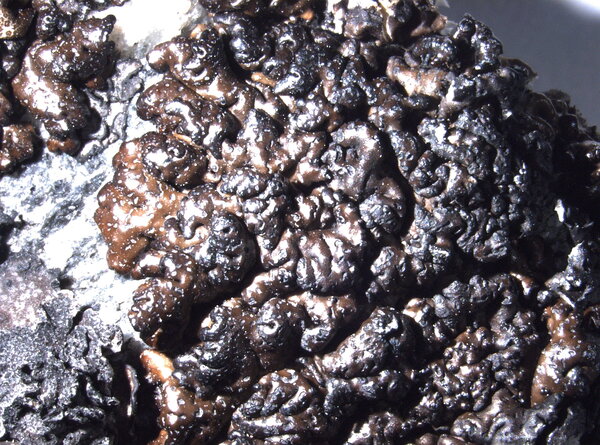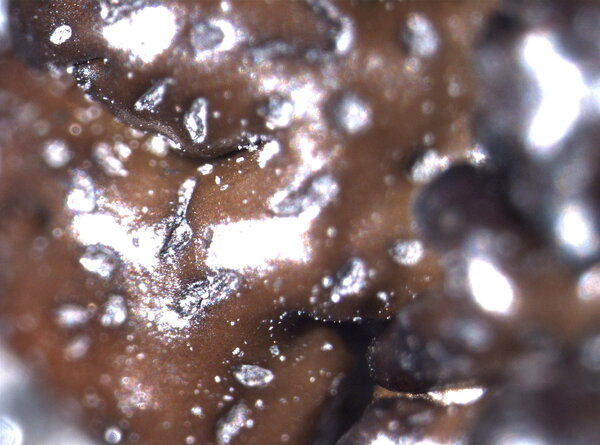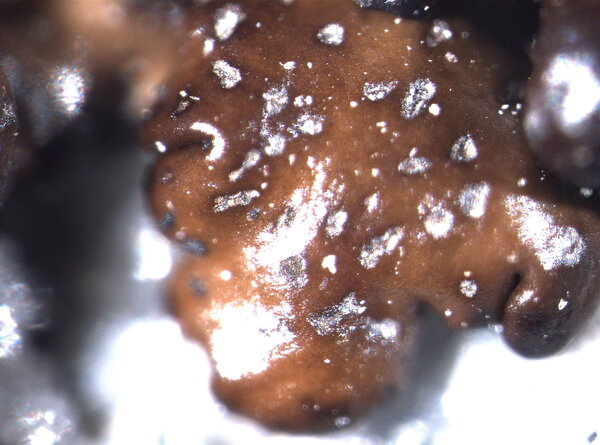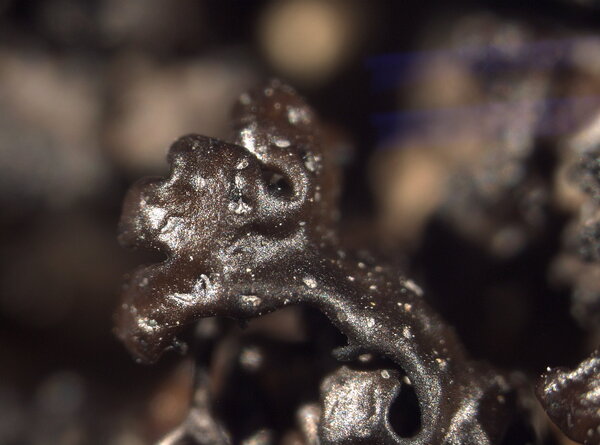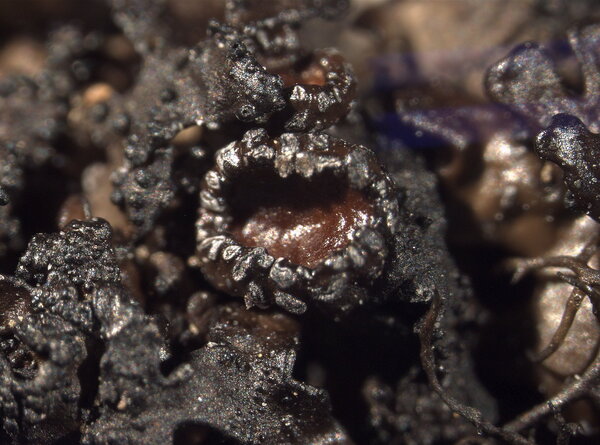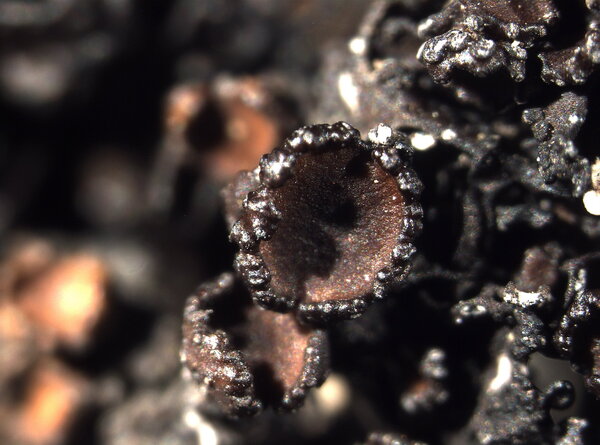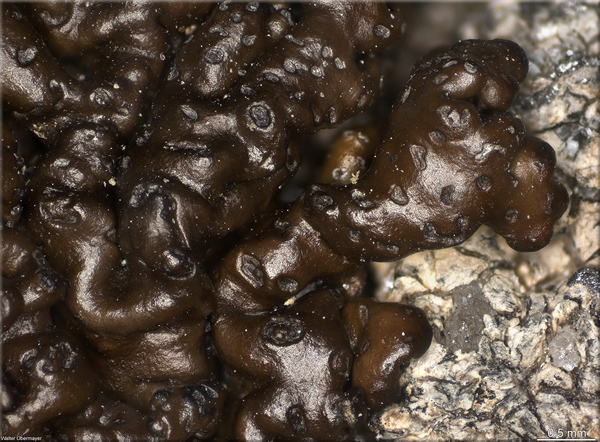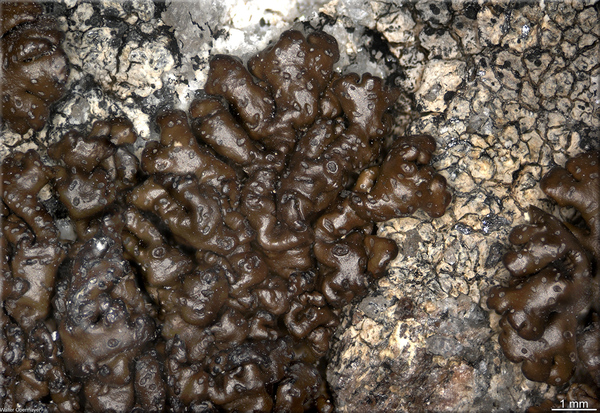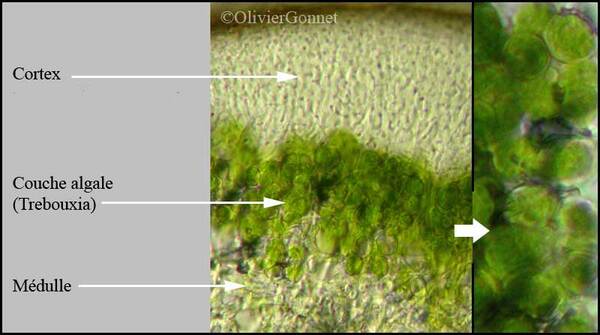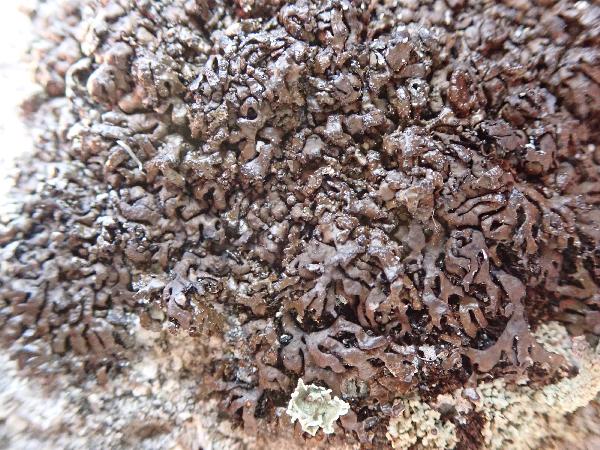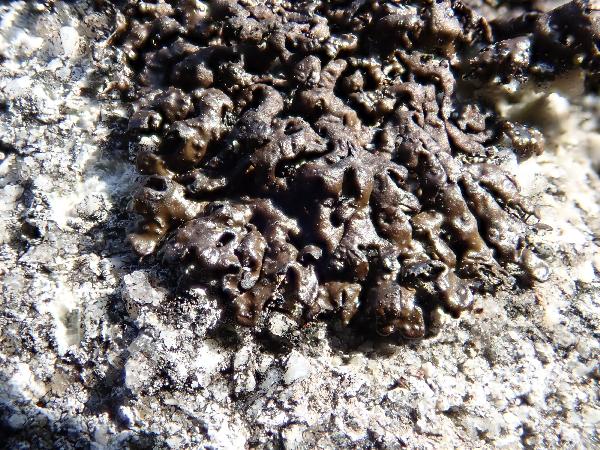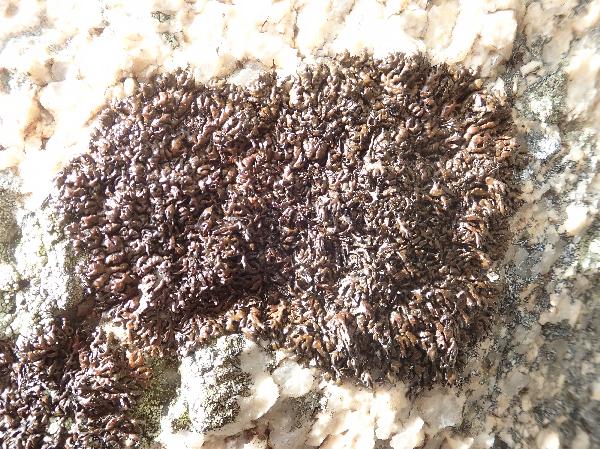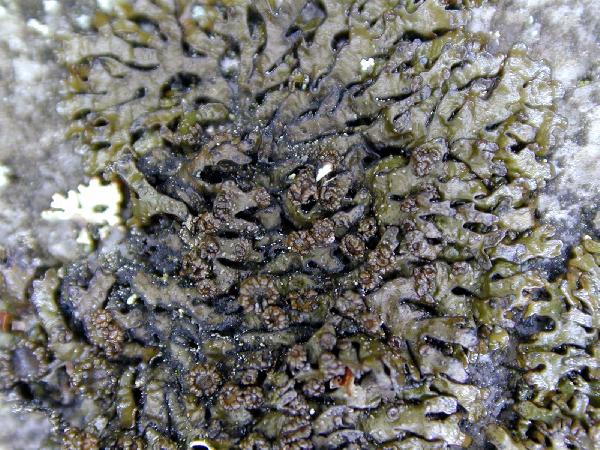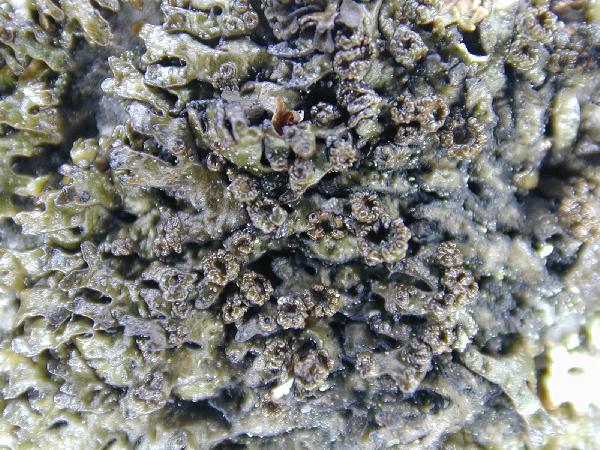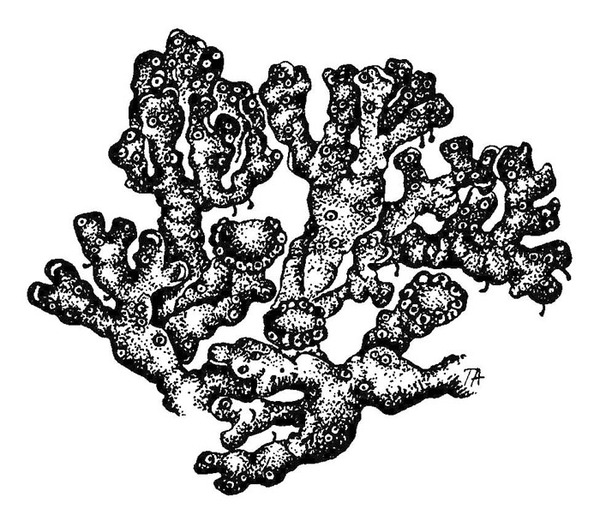Melanelia stygia (L.) Essl.
Mycotaxon, 7: 47, 1978. Basionym: Lichen stygius L. - Sp. Pl., 2: 1143, 1753.
Synonyms: Cetraria stygia (L.) Schaer.; Cornicularia stygia (L.) Nyl.; Imbricaria stygia (L.) DC.; Lichen fahlunensis L.; Parmelia fahlunensis var. stygia (L.) Schaer.; Parmelia reagens (Servít) Gyeln.; Parmelia stygia (L.) Ach.
Distribution: N - Frl (Tretiach & Hafellner 2000), Ven, TAA (Caniglia & al. 2002, Thell & al. 2002, 2004, 2009, Nascimbene & al. 2022), Lomb, Piem (Isocrono & al. 2004), VA (Borlandelli & al. 1996, Piervittori & Isocrono 1997, 1999). C - Sar. S - Cal (Puntillo 1996).
Description: Thallus foliose, heteromerous, dorsiventral, adnate to ascending, forming 3-6(-10) cm wide rosettes. Lobes 1-5 mm long, (0.5-)1-2(-3) mm wide, convex (flattened in upper part), contiguous to imbricate, with thickened and usually down-turned margins. Upper surface dark brown to black (greenish brown in shade-forms), more or less glossy, with rounded to elongate, whitish, mostly marginal pseudocyphellae which are often surrounded by a raised, often darker margin; lower surface dark brown to black, matt, with scattered, mostly simple, black rhizines. Upper cortex paraplectenchymatous, with a non-pored epicortex, the cell walls containing isolichenan; medulla white; lower cortex paraplectenchymatous. Apothecia lecanorine, mostly submarginal, (2-)4-6(-8) mm across, with a dark disc and a usually knobby, pseudocyphellate thalline margin. Epithecium brownish; hymenium and hypothecium colourless. Asci 8-spored, broadly clavate, the K/I+ blue tholus penetrated by a faintly amyloid apical cushion with parallel or diverging flanks, the wall K/I-, surrounded by a K/I+ blue outer layer, Lecanora-type. Ascospores 1-celled, hyaline, broadly ellipsoid, 7-12 x 4-6 µm. Pycnidia frequent, usually numerous, black, laminal, globose, mostly immersed, often with a gaping ostiole. Conidia dumbbell-shaped (thickened at both ends), 3.5-5.5 x c. 1 µm. Photobiont chlorococcoid. Spot tests: upper cortex K-, C-, KC-, P-, N-; medulla K+ yellow turning dirty red-brown (rarely K-), C-, KC-, P+ orange-red (rarely P-), I-. Chemistry: several chemotypes, with 1) stictic and norstictic acids (major), 2) fumarprotocetraric and protocetraric acids (major), 3) no lichen substances. Caperatic, cryptostictic, menegazziaic and constictic acids have been also reported as minor substances.Note: a circumpolar, arctic-alpine lichen found on siliceous rocks in open habitats, with optimum near and above treeline; widespread in the Alps, where it reaches the nival belt, much rarer in the high Mediterranean mountains. Specimens from Calabria and Sardinia (TSB) are worthy of further study.
Growth form: Foliose, narrow lobed
Substrata: rocks
Photobiont: green algae other than Trentepohlia
Reproductive strategy: mainly sexual
Commonnes-rarity: (info)
Alpine belt: very common
Subalpine belt: rather common
Oromediterranean belt: extremely rare
Montane belt: very rare
Submediterranean belt: absent
Padanian area: absent
Humid submediterranean belt: absent
Humid mediterranean belt: absent
Dry mediterranean belt: absent
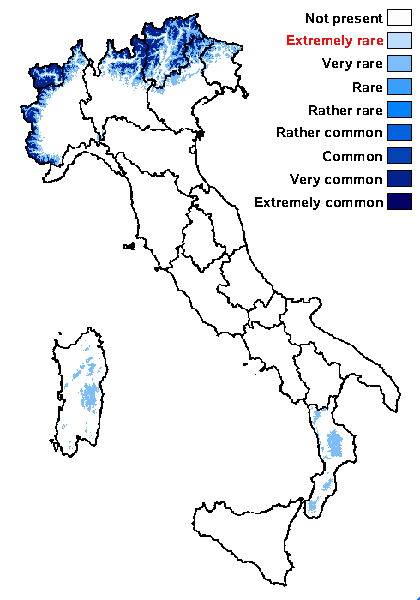
Predictive model
Herbarium samples
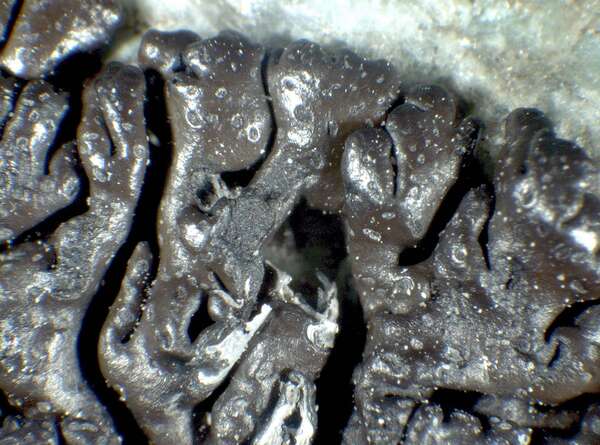

P.L. Nimis; Owner: Department of Life Sciences, University of Trieste
Herbarium: TSB (35210)
2002/07/09
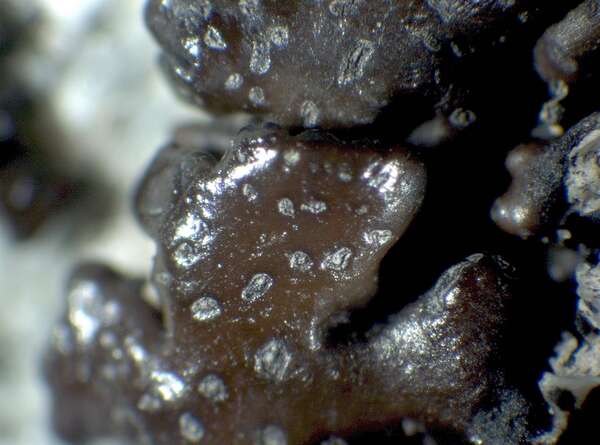

P.L. Nimis; Owner: Department of Life Sciences, University of Trieste
Herbarium: TSB (35210)
2002/07/09
pseudocyphellae
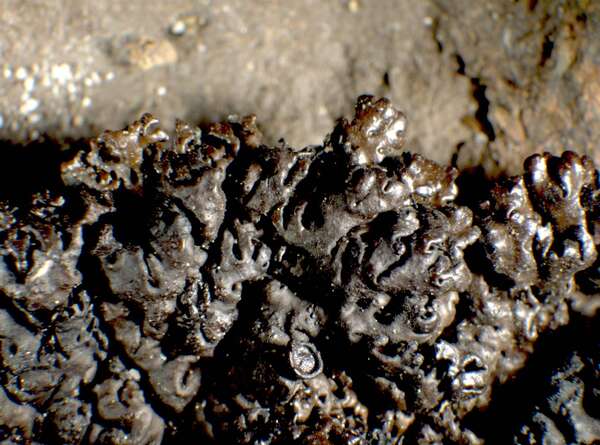

P.L. Nimis; Owner: Department of Life Sciences, University of Trieste
Herbarium: TSB (6845)
2001/12/05
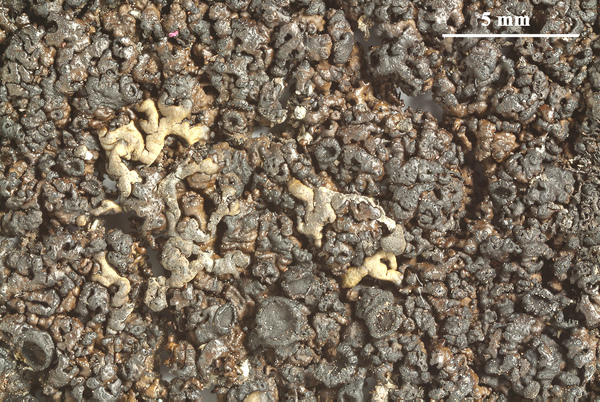

Felix Schumm - CC BY-SA 4.0
[20334], U.R.S.S. Cucasus Magnus, ad latera occidentalia montis Elbrus, loco Krugozor dicto, 3000-3100 m, ad saxa vulcanica. Leg. A. Vezda, 21.06.1980. A. VEZDA: LICHENES SELECTI EXSICCATI NR. 1539
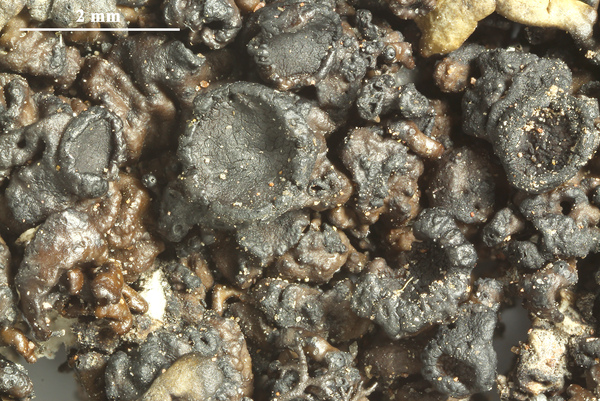

Felix Schumm - CC BY-SA 4.0
[20334], U.R.S.S. Cucasus Magnus, ad latera occidentalia montis Elbrus, loco Krugozor dicto, 3000-3100 m, ad saxa vulcanica. Leg. A. Vezda, 21.06.1980. A. VEZDA: LICHENES SELECTI EXSICCATI NR. 1539
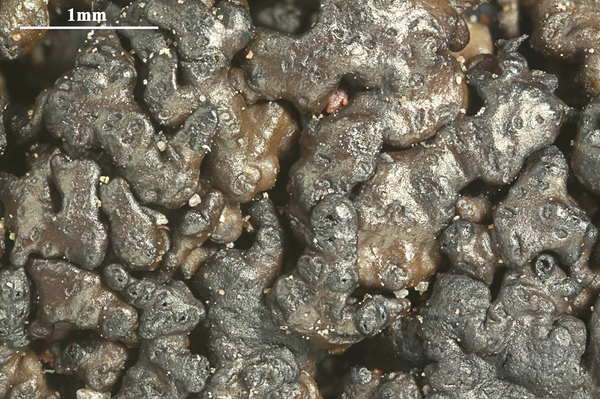

Felix Schumm - CC BY-SA 4.0
[20334], U.R.S.S. Cucasus Magnus, ad latera occidentalia montis Elbrus, loco Krugozor dicto, 3000-3100 m, ad saxa vulcanica. Leg. A. Vezda, 21.06.1980. A. VEZDA: LICHENES SELECTI EXSICCATI NR. 1539
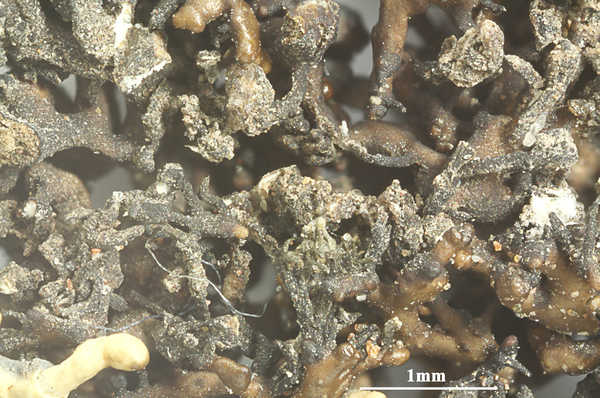

Felix Schumm - CC BY-SA 4.0
[20334], U.R.S.S. Cucasus Magnus, ad latera occidentalia montis Elbrus, loco Krugozor dicto, 3000-3100 m, ad saxa vulcanica. Leg. A. Vezda, 21.06.1980. A. VEZDA: LICHENES SELECTI EXSICCATI NR. 1539
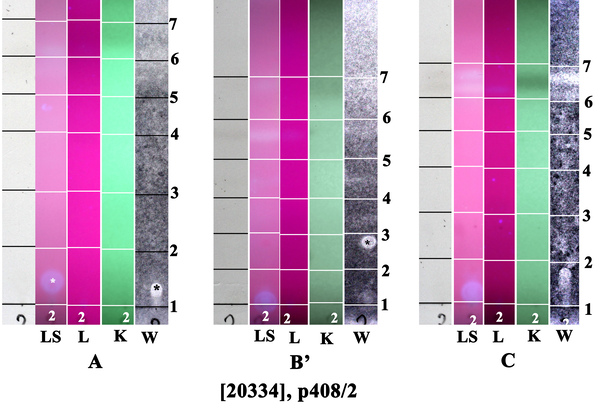

Felix Schumm - CC BY-SA 4.0
[20334], U.R.S.S. Cucasus Magnus, ad latera occidentalia montis Elbrus, loco Krugozor dicto, 3000-3100 m, ad saxa vulcanica. Leg. A. Vezda, 21.06.1980. A. VEZDA: LICHENES SELECTI EXSICCATI NR. 1539
c: caperatic acid


Felix Schumm - CC BY-SA 4.0
[20335], Bohemoslovacia, Slovacia centr., montes Štiavnické vrchy, in Monte Kamenná loco dicto Kamenné supra pagum Vyhne, 370 m, ad saxa eruptiva. Leg. I. Pišút et M. Svetlíková, 7.08.1987. A. VEZDA: LICHENES SELECTI EXSICCATI NR. 2194
c: caperatic acid
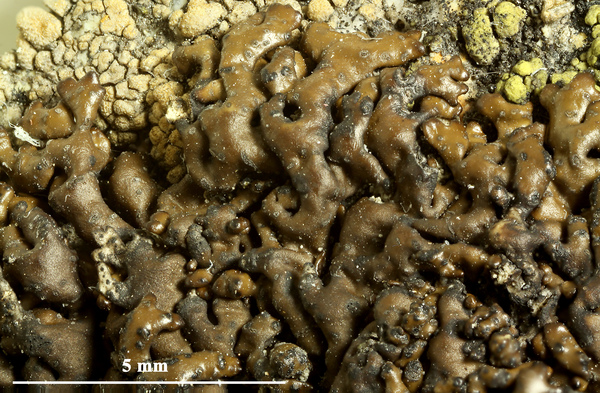

Felix Schumm - CC BY-SA 4.0
[20335], Bohemoslovacia, Slovacia centr., montes Štiavnické vrchy, in Monte Kamenná loco dicto Kamenné supra pagum Vyhne, 370 m, ad saxa eruptiva. Leg. I. Pišút et M. Svetlíková, 7.08.1987. A. VEZDA: LICHENES SELECTI EXSICCATI NR. 2194
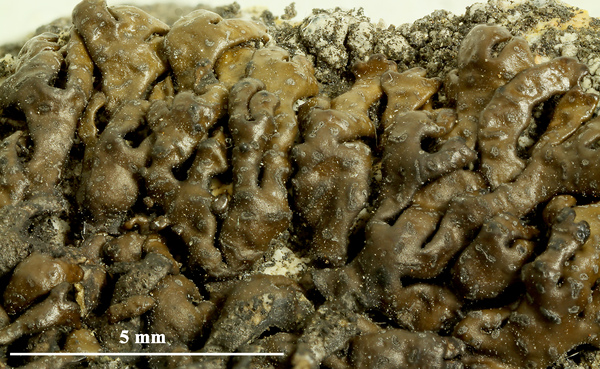

Felix Schumm - CC BY-SA 4.0
[20335], Bohemoslovacia, Slovacia centr., montes Štiavnické vrchy, in Monte Kamenná loco dicto Kamenné supra pagum Vyhne, 370 m, ad saxa eruptiva. Leg. I. Pišút et M. Svetlíková, 7.08.1987. A. VEZDA: LICHENES SELECTI EXSICCATI NR. 2194
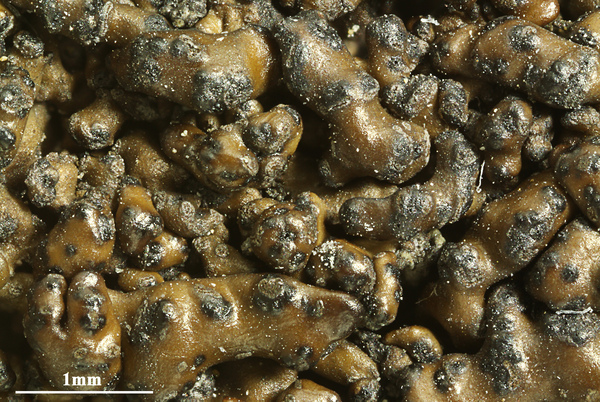

Felix Schumm - CC BY-SA 4.0
[20335], Bohemoslovacia, Slovacia centr., montes Štiavnické vrchy, in Monte Kamenná loco dicto Kamenné supra pagum Vyhne, 370 m, ad saxa eruptiva. Leg. I. Pišút et M. Svetlíková, 7.08.1987. A. VEZDA: LICHENES SELECTI EXSICCATI NR. 2194
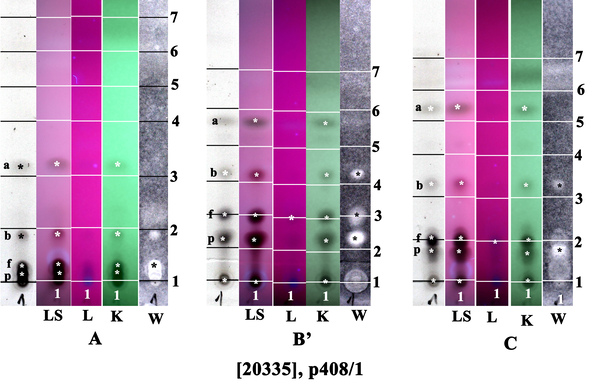

Felix Schumm - CC BY-SA 4.0
[20335], Bohemoslovacia, Slovacia centr., montes Štiavnické vrchy, in Monte Kamenná loco dicto Kamenné supra pagum Vyhne, 370 m, ad saxa eruptiva. Leg. I. Pišút et M. Svetlíková, 7.08.1987. A. VEZDA: LICHENES SELECTI EXSICCATI NR. 2194
f: fumarprotocetraric acid, p: protocetraric acid, a & b unknowns
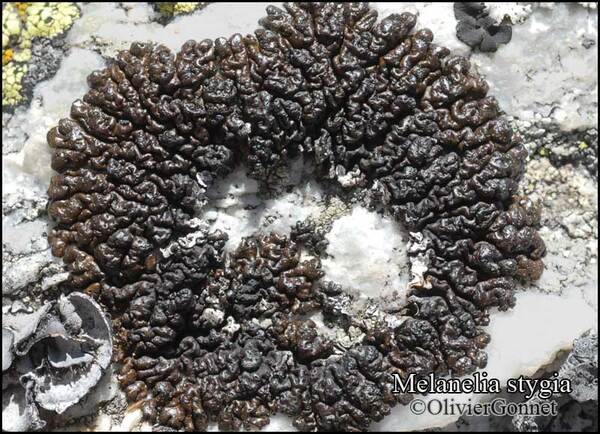
Courtesy Danièle et Olivier Gonnet - Source: https://www.afl-lichenologie.fr/Photos_AFL/Photos_AFL_M/Melanelia_stygia.htm
France, 4/8/2011 - Mont Cenis - 2081 m - Savoie

Courtesy Danièle et Olivier Gonnet - Source: https://www.afl-lichenologie.fr/Photos_AFL/Photos_AFL_M/Melanelia_stygia.htm
France, 4/8/2011 - Mont Cenis - 2081 m - Savoie
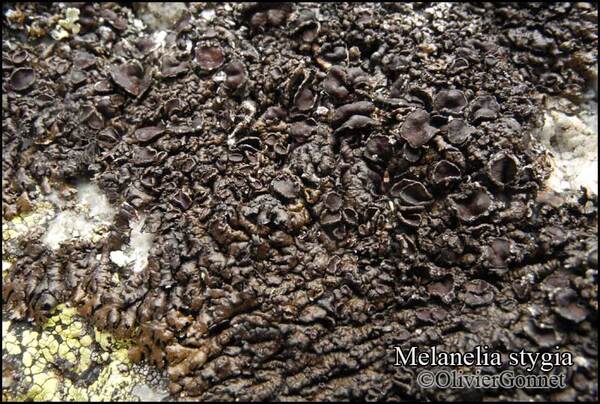
Courtesy Danièle et Olivier Gonnet - Source: https://www.afl-lichenologie.fr/Photos_AFL/Photos_AFL_M/Melanelia_stygia.htm
France, 6/10/2011 - Restonica - Corse
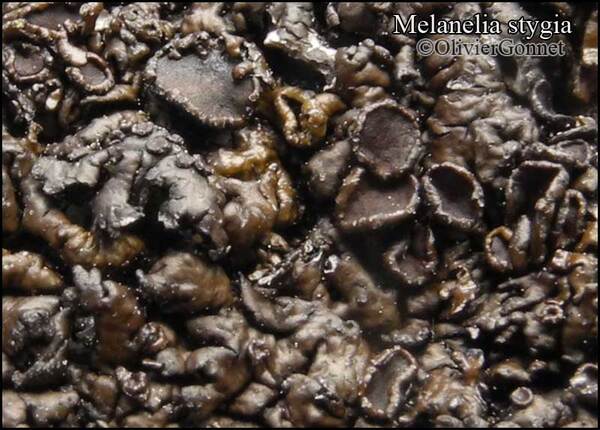
Courtesy Danièle et Olivier Gonnet - Source: https://www.afl-lichenologie.fr/Photos_AFL/Photos_AFL_M/Melanelia_stygia.htm
France, 6/10/2011 - Restonica - Corse
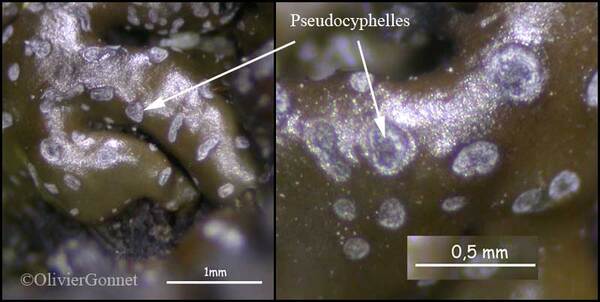
Courtesy Danièle et Olivier Gonnet - Source: https://www.afl-lichenologie.fr/Photos_AFL/Photos_AFL_M/Melanelia_stygia.htm
France, 6/10/2011 - Restonica - Corse
Growth form: Foliose, narrow lobed
Substrata: rocks
Photobiont: green algae other than Trentepohlia
Reproductive strategy: mainly sexual
Commonnes-rarity: (info)
Alpine belt: very common
Subalpine belt: rather common
Oromediterranean belt: extremely rare
Montane belt: very rare
Submediterranean belt: absent
Padanian area: absent
Humid submediterranean belt: absent
Humid mediterranean belt: absent
Dry mediterranean belt: absent

Predictive model
| Herbarium samples |


P.L. Nimis; Owner: Department of Life Sciences, University of Trieste
Herbarium: TSB (35210)
2002/07/09


P.L. Nimis; Owner: Department of Life Sciences, University of Trieste
Herbarium: TSB (35210)
2002/07/09
pseudocyphellae


P.L. Nimis; Owner: Department of Life Sciences, University of Trieste
Herbarium: TSB (6845)
2001/12/05


Felix Schumm - CC BY-SA 4.0
[20334], U.R.S.S. Cucasus Magnus, ad latera occidentalia montis Elbrus, loco Krugozor dicto, 3000-3100 m, ad saxa vulcanica. Leg. A. Vezda, 21.06.1980. A. VEZDA: LICHENES SELECTI EXSICCATI NR. 1539


Felix Schumm - CC BY-SA 4.0
[20334], U.R.S.S. Cucasus Magnus, ad latera occidentalia montis Elbrus, loco Krugozor dicto, 3000-3100 m, ad saxa vulcanica. Leg. A. Vezda, 21.06.1980. A. VEZDA: LICHENES SELECTI EXSICCATI NR. 1539


Felix Schumm - CC BY-SA 4.0
[20334], U.R.S.S. Cucasus Magnus, ad latera occidentalia montis Elbrus, loco Krugozor dicto, 3000-3100 m, ad saxa vulcanica. Leg. A. Vezda, 21.06.1980. A. VEZDA: LICHENES SELECTI EXSICCATI NR. 1539


Felix Schumm - CC BY-SA 4.0
[20334], U.R.S.S. Cucasus Magnus, ad latera occidentalia montis Elbrus, loco Krugozor dicto, 3000-3100 m, ad saxa vulcanica. Leg. A. Vezda, 21.06.1980. A. VEZDA: LICHENES SELECTI EXSICCATI NR. 1539


Felix Schumm - CC BY-SA 4.0
[20334], U.R.S.S. Cucasus Magnus, ad latera occidentalia montis Elbrus, loco Krugozor dicto, 3000-3100 m, ad saxa vulcanica. Leg. A. Vezda, 21.06.1980. A. VEZDA: LICHENES SELECTI EXSICCATI NR. 1539
c: caperatic acid


Felix Schumm - CC BY-SA 4.0
[20335], Bohemoslovacia, Slovacia centr., montes Štiavnické vrchy, in Monte Kamenná loco dicto Kamenné supra pagum Vyhne, 370 m, ad saxa eruptiva. Leg. I. Pišút et M. Svetlíková, 7.08.1987. A. VEZDA: LICHENES SELECTI EXSICCATI NR. 2194
c: caperatic acid


Felix Schumm - CC BY-SA 4.0
[20335], Bohemoslovacia, Slovacia centr., montes Štiavnické vrchy, in Monte Kamenná loco dicto Kamenné supra pagum Vyhne, 370 m, ad saxa eruptiva. Leg. I. Pišút et M. Svetlíková, 7.08.1987. A. VEZDA: LICHENES SELECTI EXSICCATI NR. 2194


Felix Schumm - CC BY-SA 4.0
[20335], Bohemoslovacia, Slovacia centr., montes Štiavnické vrchy, in Monte Kamenná loco dicto Kamenné supra pagum Vyhne, 370 m, ad saxa eruptiva. Leg. I. Pišút et M. Svetlíková, 7.08.1987. A. VEZDA: LICHENES SELECTI EXSICCATI NR. 2194


Felix Schumm - CC BY-SA 4.0
[20335], Bohemoslovacia, Slovacia centr., montes Štiavnické vrchy, in Monte Kamenná loco dicto Kamenné supra pagum Vyhne, 370 m, ad saxa eruptiva. Leg. I. Pišút et M. Svetlíková, 7.08.1987. A. VEZDA: LICHENES SELECTI EXSICCATI NR. 2194


Felix Schumm - CC BY-SA 4.0
[20335], Bohemoslovacia, Slovacia centr., montes Štiavnické vrchy, in Monte Kamenná loco dicto Kamenné supra pagum Vyhne, 370 m, ad saxa eruptiva. Leg. I. Pišút et M. Svetlíková, 7.08.1987. A. VEZDA: LICHENES SELECTI EXSICCATI NR. 2194
f: fumarprotocetraric acid, p: protocetraric acid, a & b unknowns

Courtesy Danièle et Olivier Gonnet - Source: https://www.afl-lichenologie.fr/Photos_AFL/Photos_AFL_M/Melanelia_stygia.htm
France, 4/8/2011 - Mont Cenis - 2081 m - Savoie

Courtesy Danièle et Olivier Gonnet - Source: https://www.afl-lichenologie.fr/Photos_AFL/Photos_AFL_M/Melanelia_stygia.htm
France, 4/8/2011 - Mont Cenis - 2081 m - Savoie

Courtesy Danièle et Olivier Gonnet - Source: https://www.afl-lichenologie.fr/Photos_AFL/Photos_AFL_M/Melanelia_stygia.htm
France, 6/10/2011 - Restonica - Corse

Courtesy Danièle et Olivier Gonnet - Source: https://www.afl-lichenologie.fr/Photos_AFL/Photos_AFL_M/Melanelia_stygia.htm
France, 6/10/2011 - Restonica - Corse

 INDEX FUNGORUM
INDEX FUNGORUM
 GBIF
GBIF
 DOLICHENS
DOLICHENS

